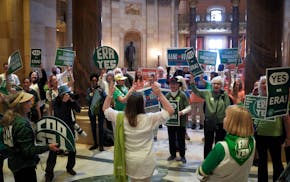"The Right Minimum Wage: $0."
That memorable free-market battle cry was the headline on an editorial in a famed American publication on Jan. 14, 1987.
"The idea of using a minimum wage to overcome poverty is old, honorable — and fundamentally flawed," thundered the Reagan-era oracles. "It's time to put this hoary debate behind us. … There's a virtual consensus among economists that … raising the minimum wage … would price working poor people out of the job market [and] increase unemployment."
In this particular case, the editorialists writing for … the New York Times! … were quite right. They were correct, that is, about the "virtual consensus" that prevailed among economists 34 years ago where minimum wages were concerned.
Fact is, it has been only in quite recent years that clear signs have emerged of something like a new consensus taking hold.
One sign that the "hoary debate" not only never was left behind but has over time taken a surprising turn has surfaced in the winter issue of the distinguished "Journal of Economic Perspectives," published at Macalester College under the editorship of Timothy Taylor, maestro of the excellent Conversable Economist blog.
A four-article Journal symposium on the minimum wage reveals that the consensus among economists "has changed a reasonable amount," Taylor cautiously explains. The gradual, much contested evolution has accelerated in the wake of the past decade's wave of bold, local minimum-wage hikes in progressive cities around the country, which has in turn set off a boom in minimum-wage studies (we've sampled this research sporadically in previous columns).
An important focus now, Taylor says, is on trying to explain why "employment effects are hard to spot."
In "The Elusive Employment Effect of the Minimum Wage," Alan Manning of the London School of Economics writes: "There is probably no economist who does not believe that there is some point at which higher minimum wages reduce employment."
Yet across numerous studies of today's real-world minimum-wage increases it turns out, Manning says, that "the employment effect is hard to find and not robust. … This literature has come to resemble trench warfare (complete with six feet of mud) in which the two sides are fighting over a small patch of ground which is not of much strategic importance in any case."
Like the Times editorialists of 1987, but in deference to a contrary conclusion, Manning thinks "[i]t is time to call a truce, acknowledge that no clear evidence of a negative effect on employment has been found, and redeploy the energy expended" — targeting what he calls "the why question."
All this surely does deliver "clear evidence" of one truth worth remembering — that no consensus of experts is ever final or foolproof.
Yet a discipline that can openly change its mind should gain in credibility what it surrenders in certainty.
Meanwhile, Taylor is quick to note that neither he nor his authors doubt that minimum-wage hikes, especially large ones, have significant effects on workers' well-being, and not always for the better.
But the uniqueness of labor markets means that those effects may not be merely, or even mainly, on the level of employment.
"The labor market involves people," Taylor says, "and people are complicated. If the price of oil rises, oil doesn't change. But both workers and employers will change their behavior when wage levels change."
Together with Manning, Taylor notes that labor markets show their unusual complexity by more or less constantly suffering at the same time a certain level of "shortage" (job vacancies employers can't fill) and a certain level of "surplus" (workers who can't find suitable jobs). The global soybean market doesn't work that way.
Two consequential adjustments to a rising minimum wage that don't involve reducing the number of jobs, Manning notes, are that businesses raise prices to cover higher labor costs, while better-paid workers stay longer in entry-level jobs, reducing turnover, hiring and training costs and improving the skill level of workforces.
But how do changes like those affect the lowest-skill workers — who presumably are the people minimum-wage hikes are most intended to help?
University of California economist Jeffrey Clemens notes in "How Do Firms Respond to Minimum Wage Increases?" that research suggests low-wage workers spend an oversized part of their incomes on the kinds of goods — food especially — whose prices are driven upward by minimum-wage hikes. This blunt's the workers' gains from higher wages.
And as low-skill jobs retain and attract more experienced workers after minimum increases make them more appealing, the least experienced may lose opportunities even though the overall number of jobs remains unchanged.
Another set of adjustments employers might use to deal with higher wage costs, Clemens reports, are reductions in "non-cash compensation" and "amenities" — health insurance benefits, time off, schedule flexibility, etc. In some cases, these may produce a "redistribution"minimum wage advocates would applaud. Higher-paid workers tend to value health care benefits more than do lower-paid workers, who first need a raise.
Meanwhile, in adjusting to higher mandatory labor costs "a lot of the action takes time," Taylor says. Already acquired equipment and facilities designed to be used by workers ("employee operated cash registers" is Clemens' example) won't be replaced immediately when wages are pushed higher. But as the time comes to retool, "less labor-intensive tenchologies" (like self-serve gadgetry) may replace staff.
None of this changes the fascinating fact that the minimum-wage consensus has evolved. Experiments with rising minimum wages likely will, and likely should, continue in prosperous places with high prevailing wages, where evidence suggests they do more good than harm.
But because the consensus has changed only "a reasonable amount," Taylor says it's important to remember that America "is a really diverse country" when considering the politically popular push for a "helluva jump" to a uniform, nationwide $15 minimum wage.
The respected Congressional Budget Office brought out a new report just last week, projecting that a coast-to-coast $15 minimum would reduce U.S. employment by 1.4 million jobs (almost 1%) while lifting almost 1 million people out of poverty.
Complexity rules, and maybe the best idea is different rules for different places. What works fine in coffee shops in Palo Alto may not work at all in rural Mississippi manufacturing plants, Taylor says. For that matter, what makes sense in the Twin Cities may be problematic in much of greater Minnesota.
And remember: Even a new consensus is neither foolproof nor final.
D.J. Tice is at Doug.Tice@startribune.com.

Let voters decide on Equal Rights Amendment

Readers Write: Graduation, child care, midwifery, Timberwolves fans

How to avoid an Uber/Lyft disaster



